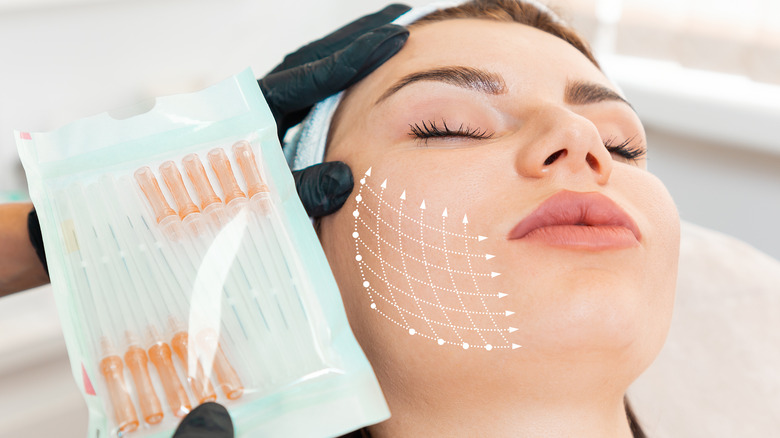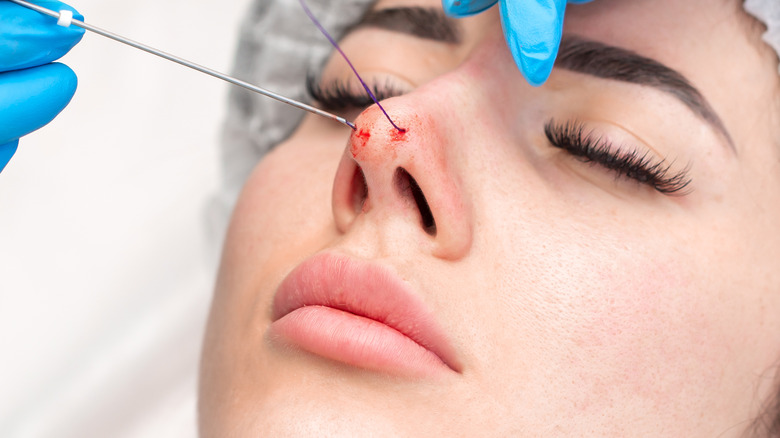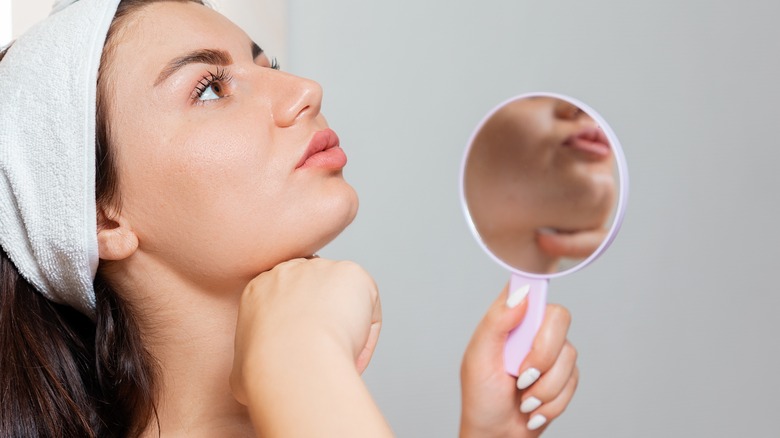What You Need To Know Before Getting A Thread Lift
When it comes to reducing sagging skin and restoring a wrinkle-free appearance, Botox and facelifts, or rhytidectomy, are among the most sought-out surgical methods. While Botox is less costly and complex than a facelift, its results are short-lived and you have to receive injections three times per year to maintain the wrinkle-free effect. On the other hand, a facelift offers long-lasting results. During the facelift, according to the Mayo Clinic, sagging skin on the cheeks and lower jawline is pulled back over the repositioned contours, tissues below the skin are elevated, and skin creases are smoothed to give the face and the neck a more sculpted shape.
However, not everyone is well-positioned to go under the knife to look younger — not to mention that surgeries come with a host of risks and complications, such as nerve injury and scarring, which make many think twice before visiting a plastic surgeon. For those on the quest for minimally invasive cosmetic treatments, a thread lift might be a better option. A minimally invasive skin tightening procedure, a thread lift sees a surgeon using threads to elevate certain portions of the skin, per Medical News Today.
With the growing demand for nonsurgical cosmetic treatments, thread lifts are becoming highly popular options to get a more defined jawline and shaped cheekbones. Below, check out everything you need to know about the pros and cons of this much-hyped beauty fix.
How does a thread lift work
Invented in 1992 by plastic surgeon Dr. Gregory L. Ruff, thread lifts are making a comeback in the cosmetic treatment scene thanks to advancements in thread technology, such as the development of completely dissolvable and stronger threads. Polydioxanone (PDO), polylactic acid (PLA), and polycaprolactone are the three major types of threads used in facelifts (PCA). PDO threads, which are constructed from a synthetic absorbable polymer with a high degree of safety, are the most often used nowadays. Some surgeons also pointed out that using threads allowed them to remedy facial issues that other non-surgical methods couldn't. "In my practice, I have found that where threads really shine is in the lower third of the face. This is a notoriously difficult area to correct with injectables," says plastic surgeon Ben Tracy (via The Aesthetic Guide).
According to WebMD, during a thread lift treatment, a surgeon temporarily places sutures under your skin to lift it or pull it back for a visibly tighter appearance. The threads used are textured filaments that grip the underside of your skin to maintain it in a new position. Rather than removing the patient's sagging skin surgically, the surgeon stitches up sections of it. Additionally, threads help trigger the body's healing response and cause it to produce more collagen at the treated sites. The procedure takes about an hour, and you'll be put under local anesthesia, which allows you to be fully awake.
Pros and cons of a thread lift
What you can expect from a thread lift is a simple procedure, quick results, and a collagen boost. Because the threads placed under the skin are so tiny, the patient will only feel a prick sensation during stitching and mild swelling for a few days following the procedure. The procedure also has a quick recovery period of no more than two weeks, per Enrich Clinic. While your facial tissues are healing, refrain from vigorous activities, smoking, facials, and wearing makeup for about two weeks after treatment. At all times, wear sunscreen when going out. If you are pregnant or have existing medical issues, consult your doctor to see if you're eligible for a thread lift.
A thread lift is not without limitations. It might be a better choice compared to injectables, but it lacks sufficient lifting and tightening power to serve as a credible alternative to a facelift. For instance, it might not be the best treatment for those with super thin or drooping skin, dermatologist Dennis Gross tells PopSugar. Besides, thread lifts are not effective against blemishes on the skin surface or deep-set fine lines, which might require a skin resurfacing method such as a CO2 laser treatment. You might need to combine various anti-aging treatments to achieve a more all-rounded, lasting result in your appearance. Because the threads disintegrate during the next six months, a follow-up treatment every 12 months is needed to maintain the results.


